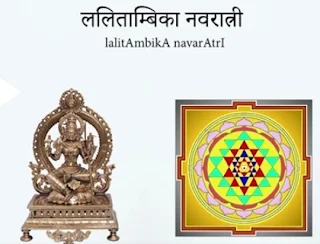In the Indic tradition, periods of transition in nature are seen to hold immense possibilities for self-transformation.
Vasanta navratri or Chaitra Navratri [significance]
- The three transition times within a day called sandhyA kAlas.
- the transitions between the waxing and the waning phases of the moon, called pUrNimA and amAvAsyA.
- the transitions between sun's northern and the southern run, called uttarAyaNa and dakShiNAyanam.
- and the transitions between seasonal shifts on the planet, called ritu.
All of these have specific celebrations and corresponding practices that one can make use of. One of such celebrations, are the navaratris.
When I say Navaratri celebrations, you probably think of the Durga puja celebrations that happen during september. But did you know that there are actually four navaratris that are celebrated throughout the year?
We'll look at the practices and processes corresponding to the chaitra navaratri festival, and how you can make the best use of this traditional wisdom.
Four types of Navratri:
| Number | Navratri name | Celebration time |
| 1 | ShAradIya Navratri, or sharannavarAtri | Just after the monsoon season is complete |
| 2 | Vasanta navaratri or Chaitra navaratri | The start of spring |
| 3 | AShADa navratri | Just after summer |
| 4 | MAgha navaratri | The beginning of winter |
This table lists out the four navaratris, and the transition times of nature they represent. As we see, shAradIya navratri, or sharannavarAtri is celebrated just after the monsoon season is complete. vasanta navratri or chaitra navaratri indicates the start of spring, AShADa navratri is celebrated just after summer, and mAgha navratri is celebrated at the beginning of winter.
Out of these four, the first two, sharannavarAtri and chaitra navaratri are celebrated more prominently because they indicate a significant shift in the length of day and the length of night respectively.
While shArada navaratris celebrate the september equinox, after which the length of the nights starts to become longer than the length of the day, chaitra navratri celebrate the march equinox, after which the length of the days starts to become longer than the length of the nights.
All these four navaratris also fall on the first nine nights of the waxing phase of the moon, called shukla pakShaH, starting from pratipadA, or prathamA until navamI.
These nine nights of Navratri are split into three groups of three nights each, belonging to the qualities of:
| Tamas | Which can be thought of as interia |
| Rajas | Which can be thought of as compulsive passion |
| Sattva | Which can be thought of as vitality |
The celebration of these nine nights, are intended to slowly move a sAdhaka from the mode of tamas, to the mode of sattva.
Chaitra navratri is also called as lalithAmbikA navrAtrI, where goddess lalitha, the presiding deity of the auspicious shri yantra is worshipped.
The nine nights starting from chaitra prathamA to chaitra navami are spent in various rituals corresponding to the nine perimeters or AvaraNas of the shrI yantra. Various rituals like homas and pArAyaNas are conducted to imbibe the grace of goddess lalitha and other corresponding deities of the shrI yantra. You can follow the social media links to Devipuram, to learn more about the processes conducted during this period.
While the sharannavrAtri celebrations culminate on vijayadashami, chaitra navaratri culminates with the celebration of shrI rAma navamI. Hymns and chants corresponding to Lord Rama, like the Rama Raksha Stotram, Aditya hRdayam, and other verses from Valmiki Ramayanam are chanted during this time.
Each of these festivals also have specific processes and rituals making use of the natural produce corresponding to that season.
Chaitra navratri also indicates the start of the new year in many traditions across bhArat, where it is celebrated by the names of yugAdi or ugAdi, guDI pADwA, chaitrI chandra or cheTI chAnd, and so on...
This is celebrated as the traditional new year as it brings about a significant shift in the surrounding temperatures, and therefore the behavior of both microscopic and macroscopic life on the planet.
People indulge in the practices in Navratri:
| Practice | Meaning |
| PanchAnga SravaNam: | Predictive forecasts for the upcoming year. |
| Aushadha Sevanam: | Consumption of medicinal recipes that boost immunity. |
| Stotra PaThanam: | Chanting of hymns that invoke vibrance and vitality within the body. |
I hope you make the best use of this period of natural transition in the atmosphere. May it bring about good health, vibrance and prosperity to all of us! I hope that you enjoyed reading this article and found it useful.
![Vasanta navaratri or Chaitra Navratri [significance] Vasanta navaratri or Chaitra Navratri [significance]](https://blogger.googleusercontent.com/img/b/R29vZ2xl/AVvXsEihhqLNewzMa-Ek0qCCqXuVjGhz_iPoemxTzhSVaflSkcGOtWkap2ur5I-w7tUJ4WVE-km-bVeVxIFFJH1fAywO3jGKVq5QB8JeRqOFM3q6lb_qyzXOZslWMKR6vZYw84WVzWxfrkBYfYg/w320-h160-rw/20200411_151934_0000.png)

